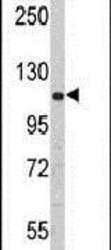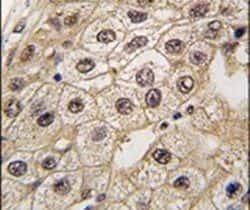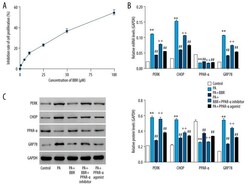Antibody data
- Antibody Data
- Antigen structure
- References [1]
- Comments [0]
- Validations
- Western blot [1]
- Immunohistochemistry [1]
- Other assay [1]
Submit
Validation data
Reference
Comment
Report error
- Product number
- PA5-15305 - Provider product page

- Provider
- Invitrogen Antibodies
- Product name
- PERK Polyclonal Antibody
- Antibody type
- Polyclonal
- Antigen
- Synthetic peptide
- Reactivity
- Human
- Host
- Rabbit
- Isotype
- IgG
- Vial size
- 400 µL
- Concentration
- 2 mg/mL
- Storage
- Store at 4°C short term. For long term storage, store at -20°C, avoiding freeze/thaw cycles.
Submitted references Berberine (BBR) Attenuated Palmitic Acid (PA)-Induced Lipotoxicity in Human HK-2 Cells by Promoting Peroxisome Proliferator-Activated Receptor α (PPAR-α).
Wu Y, Chen F, Huang X, Zhang R, Yu Z, Chen Z, Liu J
Medical science monitor : international medical journal of experimental and clinical research 2019 Oct 14;25:7702-7708
Medical science monitor : international medical journal of experimental and clinical research 2019 Oct 14;25:7702-7708
No comments: Submit comment
Supportive validation
- Submitted by
- Invitrogen Antibodies (provider)
- Main image

- Experimental details
- Western blot analysis using a PERK polyclonal antibody (Product # PA5-15305) in 293 cell lysates (35 µg per lane).
Supportive validation
- Submitted by
- Invitrogen Antibodies (provider)
- Main image

- Experimental details
- Immunohistochemical analysis of formalin-fixed, paraffin-embedded human hepatocarcinoma tissue using a PERK polyclonal antibody (Product # PA5-15305), followed by HRP-conjugated secondary antibody and DAB staining.
Supportive validation
- Submitted by
- Invitrogen Antibodies (provider)
- Main image

- Experimental details
- Figure 1 BBR ameliorated PA-induced ER stress in HK-2 cells via PPAR-a pathway. ( A ) Cell proliferation was assessed after 24 hours of BBR exposure (0, 1, 5, 10, 50, and 100 muM), using method CCK-8. HK-2 cells, stimulated with PA (0.1 mM), were treated with 100 muM of BBR, BBR+10 muM of PPAR-a inhibitor (GW6471), and 5 muM of PPAR-a agonist (fenofibrate), respectively. After treatment at 24 hours: ( B ) mRNA and ( C ) protein levels of PERK, CHOP, PPAR-a, and GRP78 were assessed by RT-PCR and western blot, respectively. ** P
 Explore
Explore Validate
Validate Learn
Learn Western blot
Western blot